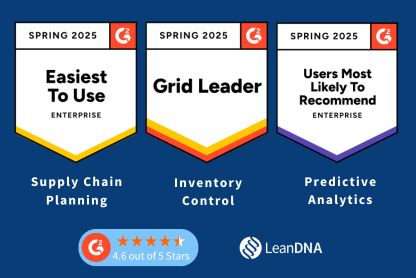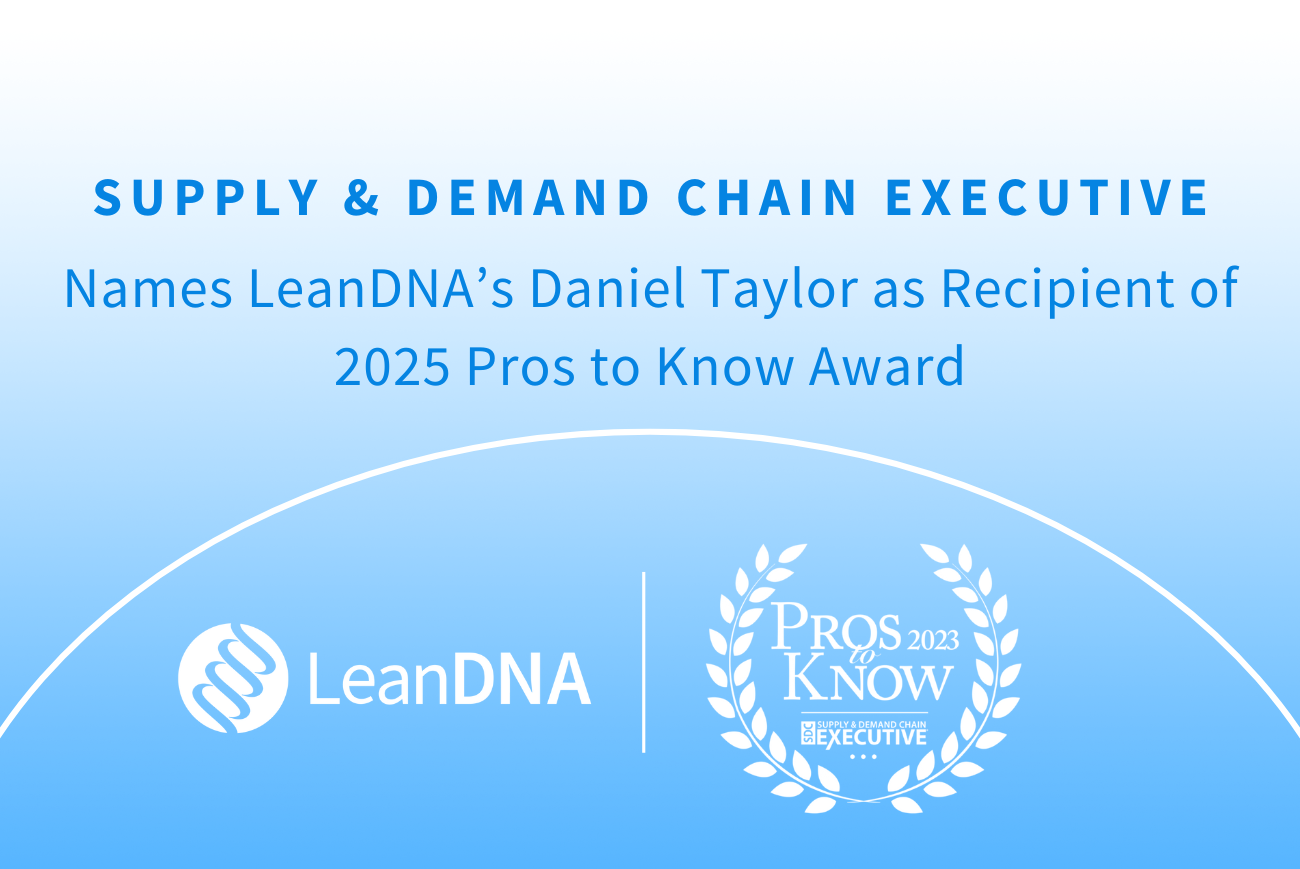CASE STUDY – Inventory Optimization
In 2018, supply chain teams at Safran began searching for a solution that provides prioritized, automated actions to address shortages and to make daily inventory optimization decisions using robust inventory optimization techniques.

The company’s IT team took the initiative to solve this technology gap with LeanDNA, an inventory optimization command center that could leverage the wealth of data available in Baan, glean valuable insights, and surface targeted daily action recommendations to improve inventory results.
Below, we’ll explore in greater detail the challenges the Safran team faced, the ways their previous efforts to solve this technology problem came up short, the ease with which Business Intelligence Lead Craig Jarman successfully led the implementation of LeanDNA Inventory Analytics, and the immense impact to inventory KPIs Safran stakeholders anticipate as a result of this project.
Key Challenges in Shortage Management and Inventory Optimization
Safran Seats GB—formerly an arm of Zodiac Aerospace, which was recently acquired by Safran—produces top-of-the-line business and first-class aircraft seats including the Aura, Optima, and Venus models, for airlines and original equipment manufacturers, as well as managing repair and aftermarket inventory. The business has three sites throughout the UK, all of which rely on Baan ERP software to manage manufacturing processes. Of the seven Safran Seats sites across the globe, six currently use LeanDNA.
Before implementing LeanDNA, the supply chain teams at Safran Seats GB were facing several challenges tied to data and reporting that resulted in inventory slowly but significantly increasing over time. Without an analytics tool that specifically addressed the problem of inventory optimization, team members across the organization were developing their own custom reporting solutions in Microsoft Excel.
Because of this widespread practice of manually building out spreadsheet reports, the data, insights, and subsequent actions that arose from the reporting were inconsistent across roles and teams. There was no single source of truth on which to base inventory optimization decisions.
“In meetings, one person would say the value was x, one said y. And so the meeting was spent in disagreement about who was right.”
– Craig Jarman, Business Intelligence Lead, Safran Seats GB
With all of this siloed, manual reporting came the additional hurdle of inefficient communication and sharing of information. Team members were constantly sending emails back and forth to one another, which led to certain details and nuances getting lost in translation, or issues lingering with no clear idea of whether they’d been resolved or actioned. “The time delay of communicating back and forth with the team through emails was very poor,” said Jarman.
Challenges included:
- Ballooning on-hand inventory levels
- No analytics tool to meet supply chain needs
- Manual spreadsheet processes
- No single source of truth for data
- Inefficient collaboration in one-off emails, phone calls, and spreadsheets

Previous Efforts
The Safran IT team had previously tried to address the organization’s supply chain reporting needs in other ways. Jarman and his colleagues primarily relied on SAP Crystal Reports, a BI tool. When someone in the business requested a report on particular metrics or data sets, the IT team would build a Crystal Report and place it on a shared drive for stakeholders to access. “Nine times out of ten, it’d usually involve Excel, too, because they’d want to do some slicing and dicing of data,” said Jarman. “And then you’d have multiple people taking that file, going away and slicing and dicing it in umpteen different ways, and then obviously each different person is coming up with a different answer.”
So this approach led to the same issues of inconsistency and siloed reporting and data analysis. Additionally, the IT team couldn’t possibly fulfill all the Crystal Report requests coming its way. With just three individuals with the Crystal skill set and 1600 employees in the business, this reporting solution just wasn’t scalable or sustainable over the long term.
So when a colleague informed Jarman about the LeanDNA Inventory Analytics solution, he and his IT team were primed and ready for fresh ideas. The business users on the supply chain team were also very keen to acquire a tool which could provide a better framework for organizing and optimizing their daily activities. After an initial demonstration of the tool, Jarman and the team were enthused: “I walked away from the presentation and my initial reaction was ‘Wow, when can we have it?’ I thought, ‘I need this and I need it now. Can we get it signed off?’”
The Results
Implementation
After signing on with LeanDNA, Jarman said the implementation process went quickly and smoothly. The LeanDNA team explained the plan to securely connect to Safran’s ERP on premises, and clearly identified the specific, targeted data mapping requirements that would allow LeanDNA to quickly integrate with their Baan system.
“I’ve been in IT for a number of years. I have good knowledge of every single table in our ERP system. I know of all the fields and functions. So, when I get a document on my desk saying we just need to map into this table, this table, this table—it was a straightforward process that didn’t take me long.”
– Craig Jarman, Business Intelligence Lead, Safran Seats GB
Jarman worked with his dedicated LeanDNA customer success manager, Germain Lavalade, along with Tim Hiers, LeanDNA’s lead data integration engineer, to meet his team’s unique needs. Jarman’s special request to map a few additional tables from the ERP was addressed seamlessly, with little to no additional effort needed from Jarman’s team. “There were a couple of tweaks we had them make in data validation just to make sure everything was 100 percent perfect. It all went pretty flawlessly, to be honest.”
Other IT projects Jarman has worked on tend to take significantly longer to execute, and often fail altogether, for any number of reasons. “With LeanDNA, implementation was a breath of fresh air. It was ‘This is what I want, this is how we should do it,’ and LeanDNA just did it perfectly every single time. It went smoothly, efficiently, effortlessly—it was all good.”
Training and Onboarding
His team was also thrilled with the training and onboarding process led by the LeanDNA customer success team. Lavalade offered a thorough demonstration of the platform’s functionality, highlighting the key reports and features that would most benefit the Safran team. He was eager to spend as much time as the team members needed to become comfortable using specific elements of the tool, provide step-by-step instructions, and answer any questions along the way.
“The fact that we had training with LeanDNA was a massive benefit. To have someone on the other end of the line and be able to say ‘I have an issue with this’ or ‘I don’t understand it,’ and have someone to sit down, talk you through it, and demonstrate is a huge positive.”
– Craig Jarman, Business Intelligence Lead, Safran Seats GB
Inventory Optimization Techniques and Collaboration
Features like the Shortages Report, where the Safran team can easily see impacted orders and analyze root cause, and the task element, which allows team members to collaborate and assign action items right from LeanDNA, have been especially useful. With automatic, system-generated email notifications, team members no longer spend time chasing email communications with their colleagues. LeanDNA provides a centralized point of communication with a history of tasks and actions visible for all stakeholders to refer back to.
LeanDNA has also helped the Safran supply chain team surface critical data quality issues in their ERP so they can take action to clean them up over time. They’re more easily able to uncover inaccuracies in things like lead times, Purchase Price Variance (PPV), requirement dates, and order policies, and collaborate to fix them. In turn, this helps their business run more smoothly and allows LeanDNA to provide even better insights to the supply chain teams.
“Our Crystal reports were old, written by people who have left the business, and there were significant errors in them,” said Jarman. “So now to have alerts sent to you from the system is highly beneficial. I know a lot of the team members are sending tasks back and forth to each other, like, ‘I’m looking at PPV and something’s not quite right. You need to modify this, you need to get it right.’”
In one example, Jarman explained how the team uncovered several work orders that had been incorrectly left open since as early as 2016, closed out physically, but left open to linger digitally. The order was creating demand for the purchasing team to buy certain parts, but the parts were unsourced. This meant a buyer was busy working with suppliers to try to source these parts for a rework order that wasn’t even wanted. The Shortages Report gave them visibility into this root cause and helped them solve the problem.
From the perspective of Jarman’s IT team, LeanDNA has helped them get the right information to their supply chain stakeholders while simultaneously taking significant work off his IT team’s plate, freeing them up to tackle other projects.
Compared with the IT team’s previous approach involving building out Crystal Reports by request, they can now easily see their current valuation for manufactured and purchased inventory, along with key metrics like PPV—right out of the box with LeanDNA.
“LeanDNA has helped us eradicate the siloed spreadsheet approach, where multiple people are doing the same things and coming to different figures. Now we just have one source of truth.”
– Craig Jarman, Business Intelligence Lead, Safran Seats GB
Expectations for the Future
Within the next 12 months, the Safran team expects to see a significant reduction in both manufactured and purchased inventory, as well as a vast improvement in other areas like PPV, thanks to LeanDNA. They also expect to reach a point where, across all sites, no demand is older than three months. Additionally, the continuous improvement team is currently transferring the business’s Hoshin Kanri process from Excel and PowerPoint into LeanDNA’s Lean Projects tool, which will enable vastly more effective collaboration across teams.
“LeanDNA has helped us shine a light on our inventory issues,” Jarman said. “The next part of the journey now is to sit down as a team, look at our data, look at what LeanDNA is doing for us, and take informed actions based on that.”
“LeanDNA has helped us shine a light on our inventory issues. The next part of the journey now is to sit down as a team, look at our data, look at what LeanDNA is doing for us, and take informed actions based on that.”
– Craig Jarman, Business Intelligence Lead, Safran Seats GB
- 4 weeks time it took to get up and running with LeanDNA
- Single source of truth for inventory and shortage data
Get a copy of this case study as a printable PDF.
Find out what's possible for your business



